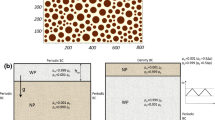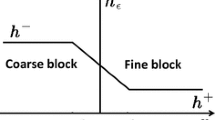Abstract
Interphase mass transfer in porous media takes place across fluid–fluid interfaces. At the field scale, this is almost always a kinetic process and its rate is highly dependent on the amount of fluid–fluid interfacial area. Having no means to determine the interfacial area, modelers usually either neglect kinetics of mass transfer and assume local equilibrium between phases or they estimate interfacial area using lumped parameter approaches (in DNAPL pool dissolution) or a dual domain approach (for air sparging). However, none of these approaches include a physical determination of interfacial area or accounts for its role for interphase mass transfer. In this work, we propose a new formulation of two-phase flow with interphase mass transfer, which is based on thermodynamic principles. This approach comprises a mass balance for each component in each phase and a mass balance for specific interfacial area. The system is closed by a relationship among capillary pressure, interfacial area, and saturation. We compare our approach to an equilibrium model by showing simulation results for an air–water system. We show that the new approach is capable of modeling kinetic interphase mass exchange for a two-phase system and that mass transfer correlates with the specific interfacial area. By non-dimensionalization of the equations and variation of Peclet and Damköhler number, we make statements about when kinetic interphase mass transfer has to be taken into account by using the new physically based kinetic approach and when the equilibrium model is a reasonable simplification.
Similar content being viewed by others
References
Abriola L.M., Pinder G.F.: A multiphase approach to the modeling of porous media contamination by organic compounds, 1, Equation development. Water Resour. Res. 21(1), 11–18 (1985a)
Abriola L.M., Pinder G.F.: A multiphase approach to the modeling of porous media contamination by organic compounds, 2, Numerical simulation. Water Resour. Res. 21(1), 9–26 (1985b)
Allen M.B.: Numerical modeling of multiphase flow in porous media. Adv. Water Resour. 8, 162–187 (1985)
Baehr, A., Corapcioglu, M.Y.: A predictive model for pollution from gasoline in soils and groundwater. In: Proceedings of the NWWA/API Conference in Petroleum Hydrocarbons and Organic Chemicals in Ground Water, pp. 144–156. Dublin, Ohio (1984)
Brusseau M.L., Popovicova J., Silva J.A.K.: Characterizing gas–water interfacial and bulk-water partitioning for gas phase transport of organic contaminants in unsaturated porous media. Environ. Sci. Technol. 31, 1645–1649 (1997)
Chen L., Kibbey T.C.G: Measurement of air–water interfacial area for multiple hysteretic drainage curves in an unsaturated fine sand. Langmuir 22, 6674–6880 (2006)
Chen, D., Pyrak-Nolte, L., Griffin, J., Giordano, N.: Measurement of interfacial area per volume for drainage and imbibition. Water Resour. Res. 43, W12504 (2007). doi:1029/2007WR006021
Coats K.H.: An equation of state compositional model. Soc. Petroleum Eng. J. 20, 363–376 (1980)
Crandall D., Ahmadi G., Leonard D., Ferer M., Smith D.H.: A new stereolithography experimental porous flow device . Rev. Sci. Instrum. 79, 044501 (2008)
Culligan K.A., Wildenschild D., Christensen B.S.B., Gray W., Rivers M.L., Tompson A.F.B.: Interfacial area measurements for unsaturated flow through a porous medium. Water Resour. Res. 40(12), 1–12 (2004)
Falta R.W.: Numerical modeling of kinetic interphase mass transfer during air sparging using a dual-media approach. Water Resour. Res. 36(12), 3391–3400 (2000)
Falta, R.W.: Modeling sub-grid-block-scale dense nonaqueous phase liquid (DNAPL) pool dissolution using a dual-domain approach. Water Resour. Res. 39(2) 1360 (2003). doi:10/1029/2003WR002351
Gray W. G., Hassanizadeh S.M.: Averaging theorems and averaged equations for transport of interface properties in multiphase systems. Int. J. Multi-Phase Flow 15, 81–95 (1989)
Gray W.G., Hassanizadeh S.M.: Macroscale continuum mechanics for multiphase porous-media flow including phases interfaces common lines and common points . Adv. Water Resour. 21, 261–281 (1998)
Hassanizadeh S.M., Gray W.G.: General conservation equations for multi-phase systems 2. Mass, momenta, energy, and entropy equations. Adv. Water Resour. 2, 191–208 (1979)
Hassanizadeh S.M., Gray W.G.: General conservation equations for multi-phase systems 3. Constitutive theory for porous media flow. Adv. Water Resour. 3, 25–40 (1980)
Hassanizadeh S.M., Gray W.G.: Mechanics and thermodynamics of multiphase flow in porous media including interphase boundaries. Adv. Water Resour. 13(4), 169–186 (1990)
Hassanizadeh S.M., Gray W.G.: Toward an improved description of the physics of two-phase flow. Adv. Water Resour. 16(1), 53–67 (1993a)
Hassanizadeh S.M., Gray W.G.: Thermodynamic basis of capillary pressure in porous media. Water Resour. Res. 29, 3389–3405 (1993b)
Held R., Celia M.: Modeling support of functional relationships between capillary pressure saturation interfacial area and common lines. Adv. Water Resour. 24, 325–343 (2001)
Imhoff P.T., Jaffe P.R., Pinder G.F.: An experimental study of complete dissolution of a nonaquieous phase liquid in saturated porous media. Water Resour. Res. 30(2), 307–320 (1994)
Joekar-Niasar V., Hassanizadeh S.M., Leijnse A.: Insights into the relationship among capillary pressure saturation interfacial area and relative permeability using pore-scale network modeling. Transp. Porous Media 74(2), 201–219 (2008)
Mayer, A.S., Oostrom, M.: Site characterization and monitoring. In: Mayer, A.S., Hassanizadeh, S.M. (eds.) Soil and Groundwater Contamination: Nonaqueous Phase‘ Liquids, pp. 97–139. American Geophysical Union Washington, DC (2005)
Miller C.T., Poirier-McNeill M.M., Mayer A.S.: Dissolution of trapped nonaqueous phase liquids: mass transfer characteristics. Water Resour. Res. 21(2), 77–120 (1990)
Millington R.J., Quirk J.P.: Permeability of porous solids. Department of Agronomy and Agricultural Chemistry. Trans. Faraday Soc. 57, 1200–1207 (1961)
Niessner, J., Hassanizadeh, S.: A model for two-phase flow in porous media including fluid–fluid interfacial area. Water Resour. Res. 44, W08439. doi:10.1029/2007WR006721 (2008)
Niessner, J., Hassanizadeh, S.M., Crandall, D.: Modeling two-phase flow in porous media including fluid–fluid interfacial area. In: Proceedings of the ASME IMECE Congress, Boston, Massachusetts, 31 October–6 November (2008)
Parker J.C., Lenhard R.J., Kuppusamy T.: A parametric model for constitutive properties governing multiphase flow in porous media. Water Resour. Res. 23(4), 618–624 (1987)
Powers S.E., Abriola L.M., Weber W.J.: An experimental investigation of nonaqueous phase liquid dissolution in saturated subsurface systems: steady state mass transfer rates. Water Resour. Res. 28, 2691–2706 (1992)
Powers S.E., Abriola L.M., Weber W.J.: An experimental investigation of nonaqueous phase liquid dissolution in saturated subsurface systems: transient mass transfer rates. Water Resour. Res. 30(2), 321–332 (1994)
Reeves P., Celia M.: A functional relationship between capillary pressure, saturation, and interfacial area as revealed by a pore-scale network model. Water Resour. Res. 32(8), 2345–2358 (1996)
Schaefer C.E., DiCarlo D.A., Blunt M.J.: Experimental measurements of air–water interfacial area during gravity drainage and secondary imbibition in porous media. Water Resour. Res. 36, 885–890 (2000)
VanAntwerp D.J., Falta R.W., Gierke J.S.: Numerical simulation of field-scale contaminant mass transfer during air sparging. Vadose Zone J. 7, 294–304 (2008)
Wildenschild D., Hopmans J.W., Vaz C.M.P., Rivers M.L., Rikard D.: Using X-ray computed tomography in hydrology. Systems resolutions and limitations. J. Hydrol. 267, 285–297 (2002)
Young L.C.: A study for simulating fluid displacements in petroleum reservoirs. Comput. Methods Appl. Mech. Eng. 47, 3–46 (1984)
Zhang H., Schwartz F.W.: Simulating the in situ oxidative treatment of chlorinated compounds by potassium permanganate. Water Resour. Res. 36(10), 3031–3042 (2000)
Author information
Authors and Affiliations
Corresponding author
Rights and permissions
About this article
Cite this article
Niessner, J., Hassanizadeh, S.M. Modeling Kinetic Interphase Mass Transfer for Two-Phase Flow in Porous Media Including Fluid–Fluid Interfacial Area. Transp Porous Med 80, 329–344 (2009). https://doi.org/10.1007/s11242-009-9358-5
Received:
Accepted:
Published:
Issue Date:
DOI: https://doi.org/10.1007/s11242-009-9358-5




